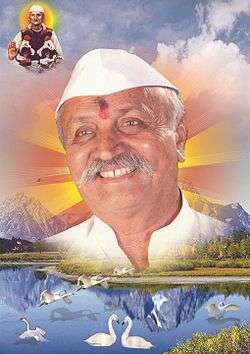Sadguru Hambir Baba
| Sadguru Hambirbaba | |
|---|---|
| Born |
Ganpat Nanaji Hambir 1879 Patethan, Tal-Daund, Pune District, British India |
| Died |
14th October 1970 Patethan, Tal-Daund, Pune District, Maharashtra, India |
| Titles/honours | Sant, a Marathi word for saint. |
| Guru | Dhondinath Baba |
| Literary works | Jeevankalechee Sadhana[1] |
Sadguru Shri Hambir Baba (Marathi: सदगुरू हंबीर बाबा) (born Ganpat Nanaji Hambir, 1879, Patethan village, Daund taluk, Pune district - died 14 October 1970, Patethan) was an Indian spiritual guide. He was a proponent of the Vedanta scriptures. He taught that the teachings of the saints can be practiced in one's personal life, in one's social life and for self-realization and social harmony.
Spiritual heritage
Baba spoke from the teachings of Richas, Shlokas, Ovees and Abhangas and was a follower of Lord Ram, Shri Krishna, other gods, their incarnations and other saints.
Early life and education
Baba was born in 1879 in Patethan village. In his spiritual education, he walked through India (for 12 years), practiced yoga-sadhana and acknowledged his vocation through callings from a religious man, "You will realize God in your own house" and from Saint Tukaram in one of his Abhangas, "God appears in your body which is His abode." Baba's teacher was Sadguru Shri Dhondinath Baba. Given Baba's origin in the village, Patetahan is known as a Dnyaneshwari, a holy centre for Sadhakas and an informal school for swadharma.
Teaching and practise of swadharma
Baba's life long spiritual mission (avatar-karya), was to teach swadharma. He used the Bhagavad Gita and the Bhagavata Purana texts in his uplifting sermons and discussions and in 1958, the Vishwavyapi Manavdharma ashram was founded.[2]
Conferences
Baba spoke at the World Religions Conferences in New Delhi in 1958, 1965 and 1967 about swadharma and peace.
Jeevankalechee sadhana
Baba wrote a book in Marathi entitled Jeevankalechee sadhana.[2] It has eight editions, has sold 20,000 copies and has been translated into Hindi and English as Swadharma: the art of life.
Sanmarga darshana
Baba taught about siddhi (spiritual power) and riddhi (prosperity).
Namamrit
Some report healings by Baba through the elixer of the name of the god (Nectar of Nam) from diseases such as tuberculosis, diabetes and leprosy. Baba indicated the Abhanga couplet,
- "Happy shall I make the whole life of mine, The three worlds, with bliss, shall I fill in."
Legacy
Baba expressed his wish to be close to his god: I yearn to go to my home!". He died in Patethan on a full moon day called kojagiri pournima.
Successor

Baba's successor was his son, Parampujya Sadguru Samartha Shri Sumantrao Hambir, (Hambirbapu) who became principal of the school in Patethan.[2] The ashram has a meditation hall, a meeting hall and a shrine to Baba. Hambirbapu teaches twenty to twenty-five days of the month in other locations in Maharashtra state.
References
- ↑ "Jeevankalechi Sadhana." Jivankala's blog.
- 1 2 3 "Vishwavyapi Manavdharma." Speaking Tree blog.
External links
- Jivankala's blog. Jeevankalechi Sadhana.
- Speaking Tree website Vishwavyapi Manavdharma.
- Jivankechisadhna.
- "Modern and global Ayurveda: pluralism and paradigms." State University of New York press, Albany. 2008 p18 and 124.
- Yoga Chicago. "Why did you decided to become an ayurvedic doctor?" (answer to second question).